












his month is our annual travel issue. And after the last year, I’m sure we are all imagining getting out there and seeing the world again. One of the blessings of military life is that it takes us to new places, pushes our boundaries, and expands our horizons in ways we never thought possible.
During my time as a military spouse, our family has been stationed in six different locations, including several OCONUS tours. The experience of new people, cities, towns, and cultures was life changing.
We moved to Japan when my twins were three, leading to legendary travel misadventures and antics. Through the laughter and tears (see picture below), we kept going, hopping on every space-available flight we could. Travel sustained us during that tour and changed our perspectives in incredible ways.

In this issue, we’ve gathered the best military travel discounts for you to get out there and make memories with your family. We’ve included the top three family-friendly spots to see while stationed in Europe. We also showcase a Newport, Rhode Island-based spouse who travels around New England photographing the quaint charm she finds in her explorations.
In our cover story, you’ll read about Gen. Brown, Chief of Staff of the Air Force, and his wife, Sharene. In this very personal interview, he shares how life can be seen in two stages — pre-George Floyd and post-George Floyd. Sharene tells us about her involvement at each duty station and their OCONUS experiences. One thing is clear from our interview — this couple knows how to make a military marriage work.
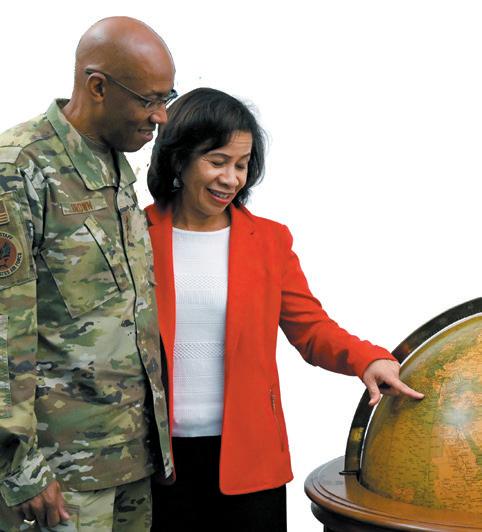
As you read these pages, I hope you find inspiration for your next




Military Families Magazine by AmeriForce Media, LLC, is published 12 times a year for active duty service members and their families. Copies are available through participating family service centers, relocation offices, transition offices, base lodges, libraries, daycare centers, MWR activities and other locations by request. Unit distribution requests can be made online at www.AmeriForceMedia.com/ mf/print-magazines/
Individuals can order a free digital edition of this issue at www.AmeriForceMedia.com/ mf/subscribe-free/
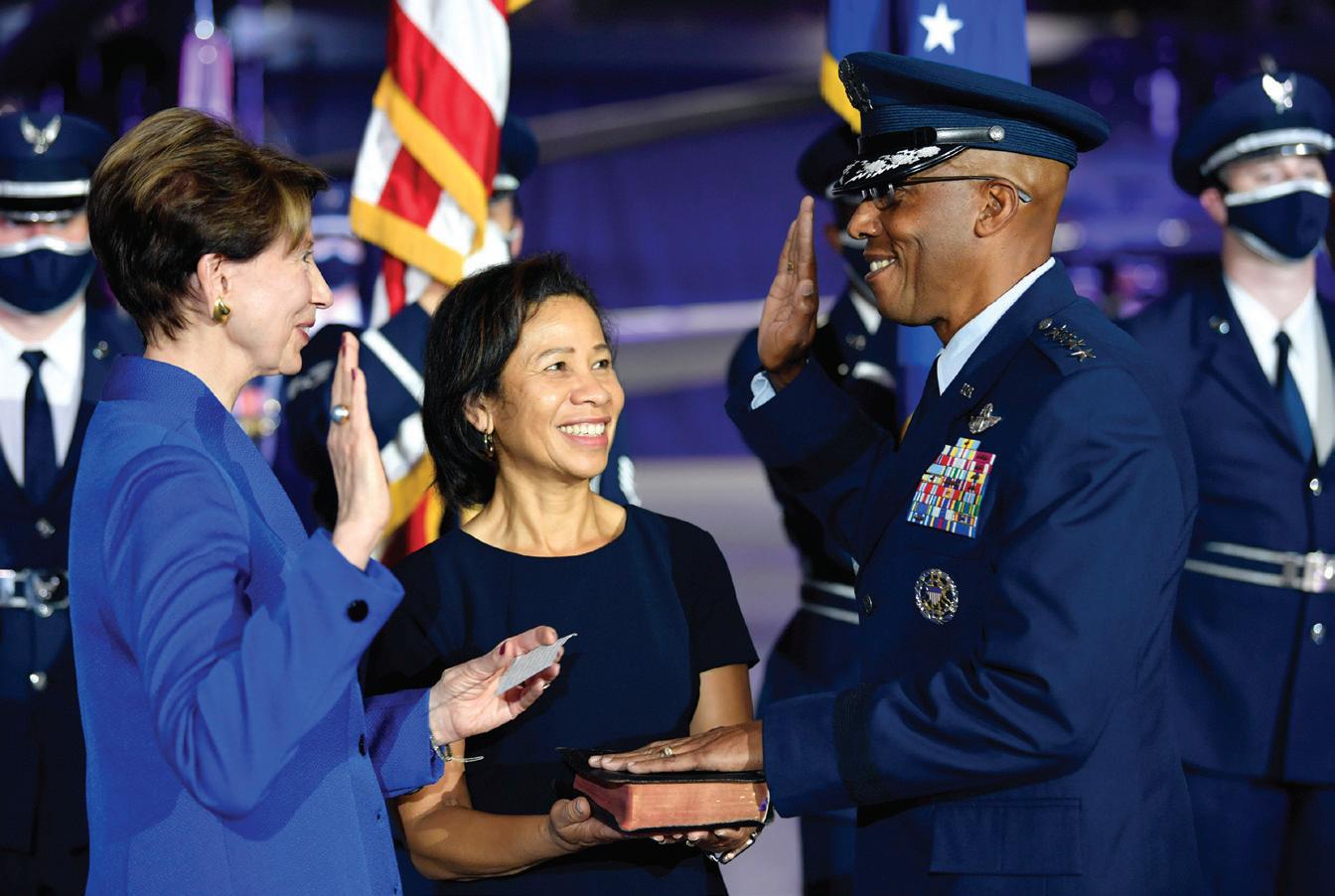
Editorial comments can be emailed to managing.editor@ameriforcemedia.com
Military Families Magazine is published by AmeriForce Media, LLC, Bloomington, Indiana, a private company. Information and advertisements in this publication do not constitute endorsement by any branch of the military or the Department of Defense. No part of this publication may be copied without the express written permission of the publishers. AmeriForce Media, LLC, the publishers, and publisher’s agents make no endorsement of any advertised services or products and none should be inferred.

President and Publisher Todd Taranto
Managing Editor Bianca Strzalkowski
Production Editor Melissa Stewart
Assistant Editor Susan Malandrino
Digital Editor Lauren Lomsdale
Design Open Look Business Solutions

ADVERTISING
PLEASE CALL 703-337-8100
Todd Taranto Publisher
Todd.Taranto@AmeriForceMedia.com
Julie Miller Vice President, Sales Julie.Miller@AmeriForceMedia.com
Ursula Hirschhaeuser Germany Sales +49 (0) 69-15053980
Ursula-Hirschhaeuser@t-online.de














































Army National Guard 2nd Lt. Corey Read said conservation and military service share common values. The Marine veteran and farmer is part of a new initiative to reduce pollution in Pennsylvania’s rivers and streams by planting 10 million trees across the state by 2025.

The Keystone 10 Million Trees Partnership, coordinated by the Chesapeake Bay Foundation, brings together a variety of nonprofit organizations, individuals, and agencies to address polluted water. The goal is to stabilize stream banks, improve soil quality, reduce flooding, and provide habitat for wildlife.
“You go overseas and serve in a combat zone and then you come home and see there are other ways to serve your country and community,” Read said.
Read and his wife, Esther, are the owners of Shupp Hill Farms , a 100-acre cattle farm located in Tunkhannock, Pennsylvania. Since taking over the family business in 2019, Read continues to explore innovative solutions to keep his family’s third-generation farm successful.

One of those solutions is conservation. His approach is to bring farming “back to the basics” through regenerative agriculture and sustainable farming methods.
“As part of our approach, we wanted to do the right thing on our farm, such as fencing off trees and waterways that are part of the Chesapeake,” Read said.
The Chesapeake Bay watershed spans more than 64,000 square miles. It encompasses parts of Delaware, Maryland, New York, Pennsylvania, Virginia, West Virginia, and the District of Columbia, and contains more than 100,000 streams and waterways and impacts 18 million people.
The program is a great fit for members of the state’s Veteran Farming Project, says Director Mimi Thomas-Brooker. The organization is a grassroots network made up of veterans, military members, and spouses who farm and operate agribusinesses.
“Veterans and military members who farm in Pennsylvania strive to be good stewards of their land. They respect soil health, clean air, and clean water — this effort will provide a resource to them to conserve the natural resources on their farms.
“A lot of our farms want to plant more trees . . . because it’s the right thing
to do but there is a cost factor there. That’s why this is a great match,” Thomas-Brooker said.
According to Read, farming is something that veterans like and sustainability appeals to this new generation of veteran-farmers.

“It’s a very close community; there’s a huge support network there and you kind of feel like you have a purpose. And I think, serving overseas you have a purpose. Farming gives you that community purpose again,” Read said.

There are many reasons to plant 10 million trees but Thomas-Brooker says the top goal is to provide healthy soil and clean water for everyone.
“Trees are instrumental in an urban setting for cooling things off . . . They help clean the air but their root systems, especially near streams are
super important to keeping drinking water clean and keeping sediment out of the stream,” she said.
According to the project’s founders, planting 10 million trees will reduce 4.6 million pounds of nitrogen, 22.2 million pounds of sediment, and 43,000 pounds of phosphorus across the state. These changes will help boost recreational activities, increase farm activity, and make the region healthier.
Back on Read’s farm, these initiatives will come to fruition in the spring once the ground thaws. He’s currently working with a consultant to determine the best tree species for his property. In the meantime, he’s taken land out of use, including wetland areas, ponds, and a stream traditionally used to water animals.
Working with the 10 Million Trees Project, a 35-50 foot buffer will be
created with what he is calling a “natural park setting along the water.” The trees will be a natural filtration system that will prevent the animals from polluting the waterways with waste. Taking this land out of use comes at a cost to the farm, but Read believes it is worth it in the long run for the farm’s sustainability, the health of the region, and the watershed.
“When I was going through officer training with the Guard, they asked me, ‘Where did you get your values from?’ I always go back to farming. I’ve always been drawn to the hard work aspect of it.
“There’s no more central tie to the community than farms,” he said. “Farms are such an integral part; they are the life force of a community. I want to continue to give back and I think the way to continue to do that is through the farm,” Read concluded.
 By Susan Malandrino
By Susan Malandrino
“There is a classic charm to New England that I don’t think you really get anywhere else in the United States. The history runs so deep, being one of the oldest parts of America,” Hammond said.
Hammond first picked up photography as a newlywed while living in Naples, Italy. Since then, she says that their family has been very fortunate to live in interesting and aesthetically pleasing duty stations in the United Kingdom and San Diego, California before returning to Rhode Island for a second time. “Newport has always held a special place in our hearts,” she said. Her daughter Jane was born here when her husband was a student attending NWC seven years ago.
“I consider myself a place-based photographer. A lot of that comes from our military lifestyle . . . the Navy has taken us to some really interesting and beautiful places. And that’s always been my source of inspiration,” she said.
While stationed in the United Kingdom, Hammond started an Instagram account as a way to showcase her print photography and capture life abroad while living in a small English village. Since that time, she’s maintained a group of online followers, she said, that appreciates the different locations the family has lived and visited. To date her account has more than 33,000 followers.
Navy spouse Shannon Hammond swoons over the quaint charm of New England’s cobblestone streets and clapboard architecture. Her travel and architectural photography, capturing everything from dramatic rocky coasts to 100-year-old covered bridges and 18th-century houses, has appeared in Condé Nast Traveler, Yankee Magazine, and Tiny Atlas Quarterly.
Hammond is based in Newport, Rhode Island, where her Navy husband, Josh, serves as a military professor at the Naval War College (NWC). She says the whole family loves this duty station and exploring New England, the northeast corner of the country comprised of Connecticut, Maine, Massachusetts, New Hampshire, Rhode Island, and Vermont.
According to Hammond, one of the great things about their current duty station is that most of New England is easily accessible. She finds herself drawn to the coast, which makes up a huge part of life and commerce in the region, including the local food and fishing industries.
“You can cover a lot of ground in a day or weekend trip. That’s one of the things that drew us to the area. And
one of the things we’ve tried to do while we are here is to take advantage of all of the great locations within an easy driving distance.
“From an architecture perspective, I just find the houses and buildings and the way that the cities are structured to be really inspiring and reminiscent of the time that we did spend in the U.K.,” she said.
Hammond says living in such a picturesque area allows her to often stumble upon character. “There are just places that make me happy to walk the streets,” she said. “When I’m doing that, I know I am going to find inspiration just wandering and admiring the old homes and architecture.”
Visiting New England? In addition to Newport, here are Hammond’s top three recommendations:



1. Woodstock, Vermont: From the charming town to the quaint shops and restaurants, Hammond says that Woodstock is bursting with quintessential New England character. You can find rural heritage, tranquil beauty, local farmers, artists, and craftspeople in this small-town community.

2. Portsmouth, New Hampshire: Settled in the 1600s, The National Trust for Historic Preservation calls this city “one of the most culturally rich destinations in the country.” For Hammond, Portsmouth has the benefits of city life without being a big city. “It feels like a small coastal village,” she said, noting the cafés, waterfront restaurants, and boutiques.
3. Kennebunkport, Maine: One of Maine’s most popular summer getaways, the town has tranquil beaches, a family-friendly atmosphere, and a laid-back vibe. While visiting, you may even catch of glimpse of Walker’s Point Estate, which belongs to the Bush family and served as the Summer White House for the late President George H.W. Bush. For Hammond, Kennebunkport is the “picture of classic coastal New England.”

The Browns are self-proclaimed foodies who explore the DMV restaurant scene and steal time for walks together. It is during these no-tech-allowed strolls when the Air Force’s top couple catch up on their days and feed their relationship. Pun intended.
And it takes work to maintain, Air Force Gen. Charles “CQ” Brown said of marriage and a military career. He and his wife, Sharene, met after he was already an airman but she was no stranger to the lifestyle. Her dad served in the military.

Sharene Brown says the adventurous side of military life has long been a favorite aspect of being a dependent ID cardholder. It is likely the characteristic that kept her “all in” throughout the decades her husband has been building a career.
“First of all, I would describe military life as adventurous. I’m an adventurous person anyway; I like to travel; I like to see different things and what not. Since coming into the military as a spouse, I have found some of the same challenges a lot of our younger spouses have found,” Sharene Brown said.
A 2019 survey found the rate of unemployment for military spouses to be 24%, according to Blue Star
Families. It is reflective of the old adage that as much as things change, they stay the same. In fact, Sharene Brown said change is the one thing that remains constant throughout the decades for those married to service members. She can also relate to hardships in pursuing and maintaining professional aspirations.

“There are things that I have experienced that I have grown from, but there are still some circumstances that are not much different. If I go back a few years to when I first came in, I was looking for a job and had a hard time finding one, moving from place to place. Then, our family started to grow … our oldest son has some learning challenges, and so the plan was to go back to work after he got into school. It didn’t necessarily work out because of the challenges and I was determined at that point to just make sure he was going to be fine,” she said. “But what I found is when one door closes, another door usually opens.”
The connections she built over the years alleviated some of the common stressors she faced. Sharene Brown was not shy to dig in at duty stations, either. She relishes in the couple’s time overseas where they often chose to live off base to get a greater sense of the culture. Her favorite location was at Doha, Qatar, where she participated on a dragon boat team.
Photo by Staff Sgt. Chad TrujilloGen. Brown also grew up as a military kid. His dad, who retired from the Army as a colonel, guided Gen. Brown through the process of applying for ROTC scholarships. Ultimately, he said, the Air Force stood out for its opportunities in engineering.
In 1984, Gen. Brown was commissioned as a distinguished graduate at Texas Tech University. He has served in a variety of positions at the squadron and wing levels, including an assignment to the U.S. Air Force Weapons School as an F-16 Fighting Falcon Instructor, according to his official biography. He said it was working with the people at that school that led to a snowball effect of positive career experiences, leading him to contemplate a long-term future with the Air Force. Then, a notable staff tour as Aide-de-Camp to the Chief of Staff of the Air Force opened his world even further.
“I got to see a bigger part of the Air Force. Exciting mission, a lot of responsibility, get to see the world, and get to meet a lot of good people,” he said.
In the summer of 2020, Gen. Brown became the first Black service chief in U.S. military history — an appointment that intersected with a period of heightened racial tension after George Floyd, an unarmed Black man, was killed by a Minneapolis police officer. Gen. Brown says he is keenly aware of the significance of his role, but also emphasizes that he wants to be judged on the merits of his performance rather than the color of his skin.


“I would say there’s a before and an after: before George Floyd and after George Floyd. Before, I already knew it [my appointment] was historical in the like, and you know I’ve thought about it but I haven’t really. Partly because, a lot of the times in the jobs I’ve been in, I’ve been either the first of or the only one. It’s probably in some cases — I hate to say it this way — it’s a bigger deal for some others than it is maybe for me because I’ve lived this. … I am who I am and I just want to be good at what I do, and be recognized as a good officer. And then after that, be recognized as a good African American officer. Just like any other officer or leader, you just want to be recognized as a good leader.
“I think after George Floyd, a bit more visibility and pressure was on the fact that I’m coming into this position. I think it adds a bit of extra weight because there’s some expectation that I’m going to be able to do things, but I’m just one person and I have almost 700,000 airmen that will have to buy into whatever good idea I come up with. And so, when we start looking at diversity and inclusion, it has to be
things the whole Air Force can buy into and not just happen because I’m sitting in this chair as Chief of Staff of the Air Force,” he said.

In 2020, leaders ordered an independent review focusing specifically on assessing racial disparity in military discipline processes and personnel development and career opportunities as they pertain to Black airmen and space professionals. The examination included a look at survey findings from more than 123,000 responses, formal interviews, and listening sessions. Results found that “varying degrees of disparity were identified in apprehensions, criminal investigations, military justice, administrative separations, placement into occupational career fields, certain promotion rates, officer and civilian professional military educational development and some leadership opportunities,” according to the report.
One example he cites is getting underrepresented demographics into aviation career fields.
“Do some of the tools we have, are they biased in some way? Not purposely but for whatever reason, we may have missed opportunities and that all comes down to exposure. We only aspire to be what we’ve been exposed to, so looking at how we can lay that out earlier for underrepresented groups, whether it’s race, gender, ethnic background,” he said.
At the same time, leaders are grappling with the ongoing pandemic that has placed restrictions on the normal way of doing business. Gen. Brown says an integral part of checking the morale and mental health of the force starts with building relationships.
about what they do in the evenings, what they do on the weekends. By building relationships, when they do have a problem, they may be more inclined to talk to you, to seek help,” he said.
The line of communication between airman and leader is also important, especially for those junior enlisted members and officers who have certain aspirations in the Air Force. Gen. Brown tells airmen to “take your chances.”
“Always ask for what you want. The worst the Air Force can do is tell you no, but they can’t tell you yes unless you ask,” he said. “I just tell airmen to explore what it is you want to be able to do, and then share that with your leadership so they have an opportunity to help you get to where you want to go. Or, to help you understand you may not be qualified for where you want to go — but you have to have the conversation. If you keep it to yourself, you may miss an opportunity or talk yourself out of it.”
Gen. Brown is adamant that his vision for a successful tour will be the same in years to come as it is today: he wants to make a difference.
Gen. Brown said small steps have been made, but his priority is to do “the deeper dive” that would include determining the root cause of the problem so recommendations can then be made of how to move forward.
“The key part is knowing your people, and you can’t know they’re having a bad day if you don’t know them — because you can’t tell the difference between a good day and a bad day. And some of that has to happen before you get into a crisis. I found just a few minutes goes a long way. It’s building relationships with the people you work with; you got a professional relationship but you also got to have a little bit of a personal relationship — know about them, their family, some of the ups and downs they have, and talk to them
“Flying was not the reason why I came into the Air Force or even why I stuck around. I mean, I like to fly, but it’s not the end-all be-all for me. It’s making a difference and that’s the key part; if I can do something that will change the Air Force for the better, make it better for our airmen and families. I would consider myself a failure if I didn’t make a difference in some form or fashion,” he added.
Follow twitter.com/GenCQBrownJr for updates on the 22nd Chief of Staff of the United States Air Force.

Army Spc. John “Alex” Pelham was killed in Afghanistan in 2014. He was 22 years old. Despite the overwhelming grief and devastation that accompanied his loss, his family is committed to inspiring others through an ongoing initiative to live — and give — like John.

His father, Wendall, had a conversation with his son two days before his death, sharing that after he hung up the phone, he knew he’d never see John again.
“There are warriors that God put on the earth to take care of us,” he said. “At his funeral I said, ‘John would be bigger in death than he ever was in life,’ and he is … as we come up on seven years since his death, that statement was prophetic.”
Described as tall and strikingly handsome, John was a magnet to the people around him. That pull would only intensify after he died.
“He was the epitome of the Green Beret moto ‘De oppresso liber,’ of freeing the oppressed. John did that all the way through school, taking care of the bullies,” Wendall said with a smile.
John’s grandfather, a 30-year veteran of the Army, was his idol. Wendall said his son sought to emulate him. Though John was successfully playing college baseball after high school, he left it all behind for a deep conviction to serve.
In July 2011, John enlisted as an intelligence analyst, leading him to become a coveted soldier with Special Forces.
John was assigned to 3rd Special Forces Group (Airborne) out of Fort Bragg, North Carolina. His skills as an analyst saved hundreds of lives, long after he was gone, his father said. After an ambush attack, he was killed alongside another soldier. On Feb. 12, 2014, at 4:34 p.m. in Oregon, Wendall’s wife called him at work to say two soldiers in dress blues were on their porch. He knew immediately John was gone.

The family of a fallen soldier says his legacy will transcend his life.
But to his family, John’s still here. He’s in every facet of what they do and how they approach life. His legacy also lives on at Fort Bragg, with his name inscribed at multiple locations.
“I get to live a part of my son’s life through mine because of his example of what a true servant looks like,” Wendall said through tears. “My son, through his service, has taught me how to be beyond a great leader. My level of empathy and care and love for fellow man is 180 degrees different now.”
After months of healing following John’s death, his family organized a racquetball tournament in his honor. The sport was one of John’s favorite pastimes and something that brought him joy. Wendall realized they needed somewhere to put the money raised, so they formed a nonprofit organization. The name? Live Like John. The mission is to support military charities, veterans, and other Gold Star families.
This doesn’t mean follow John’s more than obvious path, which was headed toward completing the “Q” course and becoming a Green Beret. But rather efforts to service others, community, and humanity.
“I learned a long time ago that to be a great leader — you have to be a servant,” Wendall said.
He encourages everyone to engage in a mission of service, but above all else, teach children to do the same. John is described as a loving man, son, brother, nephew, and friend. He was also an American soldier whose life was lived with such honor and dedication that it has had ripple effects far beyond his death.
The foundation has brought immense healing, but there are still hard days for the Pelham family: Memorial Day,
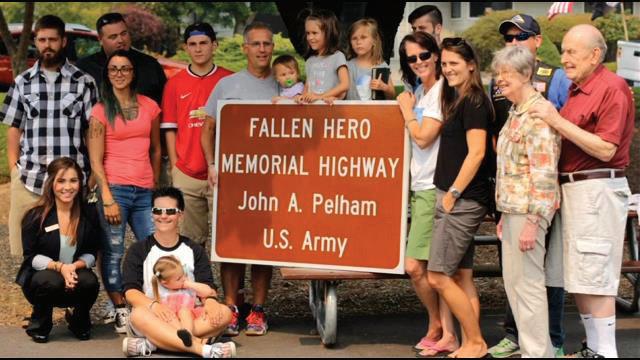

Fourth of July, Veterans Day, the holiday season, and then, the day John died.
“Your body already knows. It’s already telling me, the day, it’s coming,” Wendall said.
He adds that for those seeking to say “thank you for your service” to service members and veterans, it should be done with meaning.
“Those words said repetitiously lose their luster after a while. You can sip a Starbucks on a cold winter day or get a suntan on a beach in Maui
while traveling the world with no restriction, because you are a citizen of the United States of America,” he said. “What’s that worth? Do you understand what it is worth to the families who have given their loved ones’ lives for this freedom?”
Spc. John Pelham will be among a group of service members honored this year through The Unquiet Professional’s 2021 Virtual Memorial Mile. Visit www. theunquietprofessional.org/tupmile for updates on how you can support efforts to honor the fallen.
 By Lizann Lightfoot
By Lizann Lightfoot
Samantha Ward was in the middle of delivering her second baby before any doctors took her heart condition seriously, but she had been having symptoms since age 13. As a teen, she often felt her heart racing for no explainable reason.
“It would go from a normal pulse of 60 up to 180. I saw a specialist and wore a Holter monitor for several days [to record ECG], but they didn’t see anything happen while I wore it. It never put me in the hospital, so I just lived with it,” she said.
During her first pregnancy in 2013, Ward’s symptoms became more frequent. But when she brought
her concerns to her doctor, her symptoms were dismissed because “they were probably pregnancy related.”
It wasn’t until 2017, during another pregnancy, that Ward started seeing a cardiologist for these episodes.
“It would happen very often, and I would feel completely winded and
exhausted. I would feel like I was going to black out,” she said.
While she was in labor and hooked up to the heart monitor machines, she had another episode. For the first time, doctors could see what was happening to her heart. Ward was experiencing Supraventricular tachycardia (SVT).
SVT is an abnormally-fast heartbeat that includes a variety of heart rhythm problems. It’s a condition that can range from being mild — with minimal disruption to an individual’s
lifestyle — to severe, where the patient requires constant monitoring and medication. According to the US National Library of Medicine National Institutes of Health, more than 2 million Americans currently suffer from SVT.
For Ward, having SVT during labor was a blessing in disguise because it brought attention to her condition, but it also sent her to the ICU immediately after birth.
“When my heart races, my blood pressure drops. They could slow my heart rate down with medication but it wouldn’t stay down, so I was in the ICU while my baby was with my husband,” she said.
When she returned home, doctors prescribed a beta blocker to control her heart rate, but it made her so tired and lethargic that she was unable to take care of her kids. Ward had to stop taking the medication. Soon, her symptoms worsened again. She experienced SVTs when she was not pregnant or doing abnormal activities.
“We couldn’t figure out what triggered it. It would happen when I was just sitting still enjoying a movie. I was finally referred to an electrologist,” she said.
After years of questions, Ward finally had treatment options. Now, she has twice gone through a catheter ablation that uses electric energy to neutralize the heart tissue causing SVT. And she has a surgicallyimplanted Linq II cardiac monitor that records her heart rate and sends results to an app on her phone and to her specialist.
While her condition is not cured, Ward now has a monitor to record symptoms and a plan for future treatment. A busy mom, Ward cares
for her own four children while fostering two additional children.
Getting treatment for a heart condition can be confusing for any patient, but it is especially difficult for a military family member. Ward scheduled ablations around her Marine husband’s deployments and trainings, so he would be home to take care of their children.



When his PCS orders sent them from Virginia to Arizona, she needed a new cardiologist. During their PCS move, she researched hospitals to find the best specialist and decided to drive from Yuma, Arizona, to San Diego, California for treatment.
Getting referrals through TRICARE can be another frustrating challenge for military families with heart conditions. Thankfully, it was not an obstacle for Ward.
“TRICARE has been great through this process. If I ran out of visits
because it was being triggered more often, I contacted TRICARE directly and they would put in an extra referral. TRICARE has covered all my equipment, which includes both implants and monitors since I got a replacement device when the battery died after three years,” she explained.
For years, Ward accepted that her symptoms were normal, or just a part of pregnancy. She wished she had prioritized her health sooner instead of ignoring her condition.
“Now I google everything and want to be educated on it and learn all the risks. I know the best-case scenarios and the worst-case scenarios. I want to know every possible detail that can help me,” she said.
Ward encourages other military spouses to listen to their own bodies.
“You really need to stand up for yourself. Prioritize your health,” she added.
Although best known for serving along the coast of the country, the Coast Guard can be found all over the world. But right here at home, it also conducts operations on America’s vast and expansive river systems.
Master Chief Petty Officer Michael Love is the Officer in Charge (OINC) aboard the Coast Guard Cutter Cheyenne — a 75-foot river buoy tender homeported in St. Louis, Missouri. The Cheyenne, along with the other cutters assigned to District 8, serve 10,300 miles of inland waterways and rivers covering 21 states.
The waterways that the Coast Guard patrols have $5.4 trillion in economic impact and help sustain $30.7 million jobs annually.
Love says he always knew he wanted to enlist in the Coast Guard.
“I am a legacy guy. My grandfather was in the Coast Guard during World War II. My dad did 34 years and my brother was also in the Coast Guard,” he said.
During his 26 years of service, Love has spent a lot of time on America’s rivers.
As a Boatswain’s Mate, he holds one of the most versatile roles within the service.
“What I can tell you is what we do on the rivers versus the coast … it’s a very different world. It’s a lot more
challenging and there’s a lot more involved,” he said.
Navigating the waters of the rivers requires a keen awareness of surroundings and experience, due to the everchanging ebb and flow of the rivers.
“When we are underway, from sun up to sundown, these guys are grinding. They are dragging chain, pushing buoys over the side or they have chainsaws in their hand cutting down brush. It is very intense, and the guys are nonstop working,” Love said.
Although the river tenders aren’t underway as much as the cutters patrolling the seas, they make up for it in hard, laborious work when they are.

The Coast Guard has numerous responsibilities on the inland waterways and rivers that include things like law enforcement, protecting the environment, and search and rescue.
The Cheyenne is primarily focused on Aids to Navigation (ATON) and it works closely with the Army Corps of Engineers on this mission.
“They [Army Corps] go out and do the digging and surveys and when there’s an issue or they need buoys, we go out and mark the channel to however they designed it while maintaining our AOR,” Love said.
This work is important because of the continuous floods and droughts that
constantly assault the rivers. Without the Coast Guard ensuring safety and marking the channels, the vast movement of agricultural and energy products would not be possible. The work is hard and dirty.

When it’s time to cut down brush, it looks more like a logging expedition in a jungle, Love says.
“In one year, some of these bushes and trees will grow like 10 feet high. When we are up there – it’s like 100 degrees,” he said.
It’s laborious but important work. The Mississippi River alone is responsible for 92% of the nation’s agricultural exports, making the safety of the rivers vital to the nation.
Recently, the Cheyenne was given the 2020 Hopley Yeaton Cutter Excellence Award for servicing 1,185 buoys and 150 shore aids along 576 miles of the Mississippi River through recordbreaking high waters and floods. The crew was also responsible for responding to a search and rescue case where a woman was moments away from being pulled under a fleet of barges — saving her life.


When the units spread across the Midwest are not focusing on ATON, they have missions that include maritime security, environmental protection, and national defense. This means they are inspecting vessels and facilities throughout the major rivers to ensure seaworthiness. They also make sure these vessels are safe for people and the environment.
Despite the heavy presence in the Midwest serving its rivers, many who live within the area don’t even realize the Coast Guard is there. The perception is that the Coast Guard is only found on the coasts and nowhere else.
“I just think they need to know that we are here and to understand what we are doing,” Love said.
The pandemic has hindered so many travel plans throughout the past year. During our current tour in Naples, Italy, our family’s second OCONUS tour, we were fortunate to travel to almost half of the 44 countries in Europe before COVID-19 travel restrictions were implemented.
riding a toboggan (sled on a track) back down. You can control your ride for a casual descent or zip down at 24 mph like our 5-year-old. Other family-friendly activities include paddle-boating, touring Bled castle, biking, or walking the lake. If you can splurge a little, stay the night in a treehouse at Garden Village Bled.
While the fairytale-like scenery of Lake Bled is what attracts tourists to the country, there are plenty of other nearby destinations you don’t want to miss:
Triglav National Park
This park offers all levels of hiking in the breathtaking Julian Alps. You can also try canyoning here, which is a mixture of climbing, rappelling, and swimming in gorges and waterfalls.


Vintgar Gorge
A great place to admire the bright turquoise waters of several Slovenian rivers as you crisscross the wooden bridges built over it.
The Soča River
This river is so blue, it looks fake. Try whitewater rafting as a family activity.
We’ve trotted across the globe for several years now, with our five young kids in tow, so we’ve become fairly seasoned at finding locations that provide experiences for the entire family. If you’re stationed in Europe and travel at your duty station is approved, here are my top three family-friendly destinations to visit.
We visited Lake Blend in early September after the massive crowds had dissipated but while the transparent teal water was still warm enough for a swim. The highlight of this trip was taking a ski lift up the 2,000-foot hill at Straza Bled to enjoy the majestic views and then
Ljubjana
This super charming capital city is a foodie haven with cobbled streets and niche boutiques.
Postojna Cave and Predjama Castle
Take an underground train to get to the cave and explore for miles. The castle, which is built into a cliff, features unique medieval architecture.
Our family found the region of Puglia, the “heel” of Italy’s boot, a charismatic and less assuming attraction compared to the popular Amalfi Coast. The region has ancient cities, diverse landscapes, and alluring beaches. If you start in Bari, the location of the region’s largest airport, you can rent a car and easily hop around to see the following:
Alberobello
This endearing and picturesque town contains the famous Trulli homes.
Matera
With ancient architecture and cave dwellings, this destination is incredible but not stroller friendly. Our kids thought of the stairs, twists, and turns of the streets as a playground maze.
Zoosafari Fasano
If you’re lucky, you might get a giraffe kiss from the comfort of your car at this drive-through zoo.
Santa Maria di Leuca
This destination is the farthest south but worth the drive. You can rent a boat or take a tour of several seaside caves and even swim inside them. The water is crystal clear, calm, and great for snorkeling.
Otranto, Santa Maria di Leuca, Gallipoli, and Torre Vado
These towns, known as the Italian Maldives, all have fantastic beaches. It’s well worth the €20-€30 you’ll pay at many private beach clubs to have a set of lounge chairs, umbrella, access to bathrooms/changing rooms, a restaurant, and bar service right at your chair! Try to avoid going in August when the Italians take the whole month off for holiday.

When we planned our very first family ski trip, it seemed a bit bold to aim for the area that’s home to the highest peak in Europe—Mont Blanc. However, there are plenty of slopes well-suited for beginners. If you have young children, you can enroll them in a kids’ club, which combines ski
school with daycare. The prices for lessons, along with ski lift passes and rentals, pleasantly shocked us. It was cheaper than resorts in the states.
For some lower-key snow fun, there are several spots for other activities— tubing, luges, traditional sledding, and good old-fashioned snowball fights. For family-style après ski, taking a stroll through the idyllic streets of Chamonix will not disappoint. In December, the town hosts an outdoor craft market, and the holiday lights are left up through January, giving the town a quaint vibe.
Outside of the town, we highly recommend seeing a glacier up close. We chose Mer de Glace by way of the Montenvers train. Warning: there are exactly 430 steps to get to the ice cave (yes, we all counted), but continual references to the movie “Frozen” helped my young girls along.
There are so many great familyfriendly places in Europe other than these three destinations. My advice to anyone stationed here is to ask around for advice and take every opportunity possible to travel.
If you’re looking for more family trip inspiration or information, visit Sarah’s Facebook group Go Family Tripping, which features travel tips from around the world.

Tarolyn Thrasher, a military spouse and mother of three, is currently running for state delegate in Frederick, Maryland. As the first Black woman to run for state office in her city, she is already changing the tides of history, but those waves have been rippling since she was a 16-year-old military kid disappointed when her father left for Desert Storm.
“I was not happy about him going to Desert Storm. And so, my dad said, ‘You know the decisions that are made for us to go — big people are making those decisions.’” Thrasher quickly responded, “I want to be one of those people.”
Since that time, she’s maintained involvement in politics and a passion for her local community.
Thrasher earned a degree in political science from Troy University, and as a military spouse, served different duty stations.
“Community service is something that was just embedded in me, and I
just kept being relevant,” she said.
Thrasher’s motivation to impact others made her a leader and resource for military families. She’s served as an FTB instructor at Fort Bragg, conducting orientations for new soldiers. She’s also been a Family Readiness Group leader, sending care packages to deployed members and providing support and assistance to their spouses.
“Being a military spouse, I couldn’t get involved [in politics] as much as I wanted to because, of course, we moved around. But I did try to get involved as much as I could within the military with just connecting
with the community and community service,” she said.
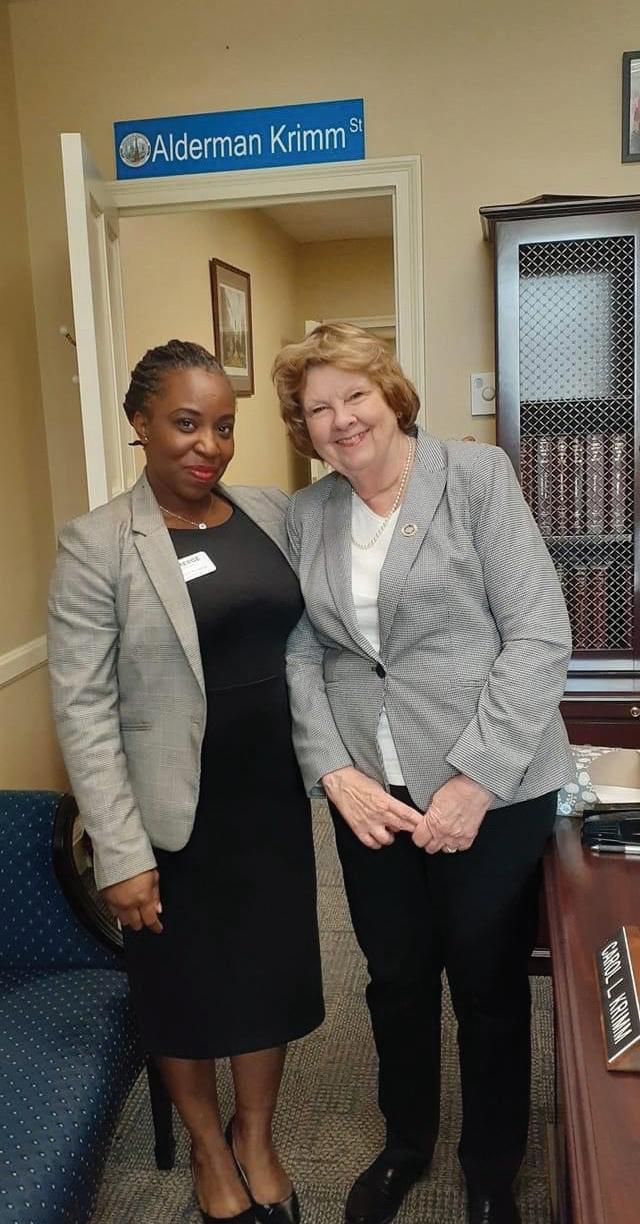
After moving to Maryland, Thrasher realized how little attention is given to the military families in the Fort Detrick area. Despite how much money is pumped into the community by its military residents, she says, the local support for military and veterans is lacking. “It’s a very weird dynamic,” and one that she has political plans to change.
In 2017, her husband retired from the Army and the family settled in the area. Thrasher now works as a program coordinator for the Baltimore Police Department. In this role, she gets an up-close view of the issues and actions that disproportionately affect Black citizens. The deaths of Freddie Gray Jr., a 25-year-old Black man who died in 2015 of injuries that he sustained while in Baltimore police custody,
As a part of Emerge Maryland, Thrasher spent a day shadowing Delegate Carol Krimm of District 3A, the seat Thrasher hopes to fill.and more recently George Floyd, an unarmed Black man asphyxiated while a Minneapolis police officer kneeled on his neck for over eight minutes, shook the country and Thrasher’s community.

“We had a lot of social injustice that was happening to the Black community, and the community that I live in is predominantly white. And so, we have a lot of inequality and loss of equity,” she explained.
Black citizens make up 19.2% of the residents in Frederick, according to the United States Census Bureau, and Thrasher says this is the best time for her voice to be heard. In December, she was named vice president of the Frederick branch of the National Association for the Advancement of Colored People (NAACP), the country’s oldest and largest grassroots-based civil rights organization. Thrasher’s influence and connection with the NAACP is an added foothold in creating political change for Black Americans.
The Center for American Women and Politics (CAWP) released figures showing 120 Black women filed to run for Congress in 2020, the highest number in history. At least 26 candidates won election or reelection to Congress.
“When you think about all the Black women that have paved the way that have not been recognized, and we’ve always had to work harder. We’ve had to be more aggressive but still not be the angry Black woman at the same time,” Thrasher said.
She decided to run after her son approached her with a story of local injustice.
“He said, ‘Mom, I don’t know when you’re going to do it, but you need to do something now and fight for us.
Like, do something for us because it’s not fair what’s happening in our community,’” she shared.
Thrasher’s ultimate goal is to make it to U.S. state secretary or state senator.
“I tell myself every day I have to make a legacy for my kids, so they know who their mom is. Don’t brag about it but take notes,” Thrasher, whose children are 22, 16, and 8, said. “I just want to be a great example for them.”

married 3 years
Their love story:
High school sweethearts Michael and Hannah have been married for three years and together for nine. They’ve already weathered military moves and time apart. After four years of exchanging love letters while Michael studied at the Naval Academy, the couple got engaged. Thirty-six days later, they married in their Mississippi hometown. Today, the Landrys are stationed in North Carolina, where Michael flies Ospreys and Hannah thrives as an Inferno Hot Pilates instructor.

Their advice:
1. Turn military life into an opportunity.
“We turned Hannah having to follow me around into an opportunity to build a business and client network across the country,” Michael said.
2. Write letters.
“When we were long distance, we would write letters every day. It helped us connect deeply and really know each other,” Hannah said.
3. Keep perspective.
According to Michael, you’re going to have differences in background and upbringing. “Recognize that what feels right to you doesn’t necessarily feel right to the other person ... and then compromise.”
continue reading on page 30
Military life poses unique challenges for personal relationships. To celebrate love and commitment this Valentine’s Day, we interviewed three military couples across generations and asked, “What’s your best military marriage advice?”
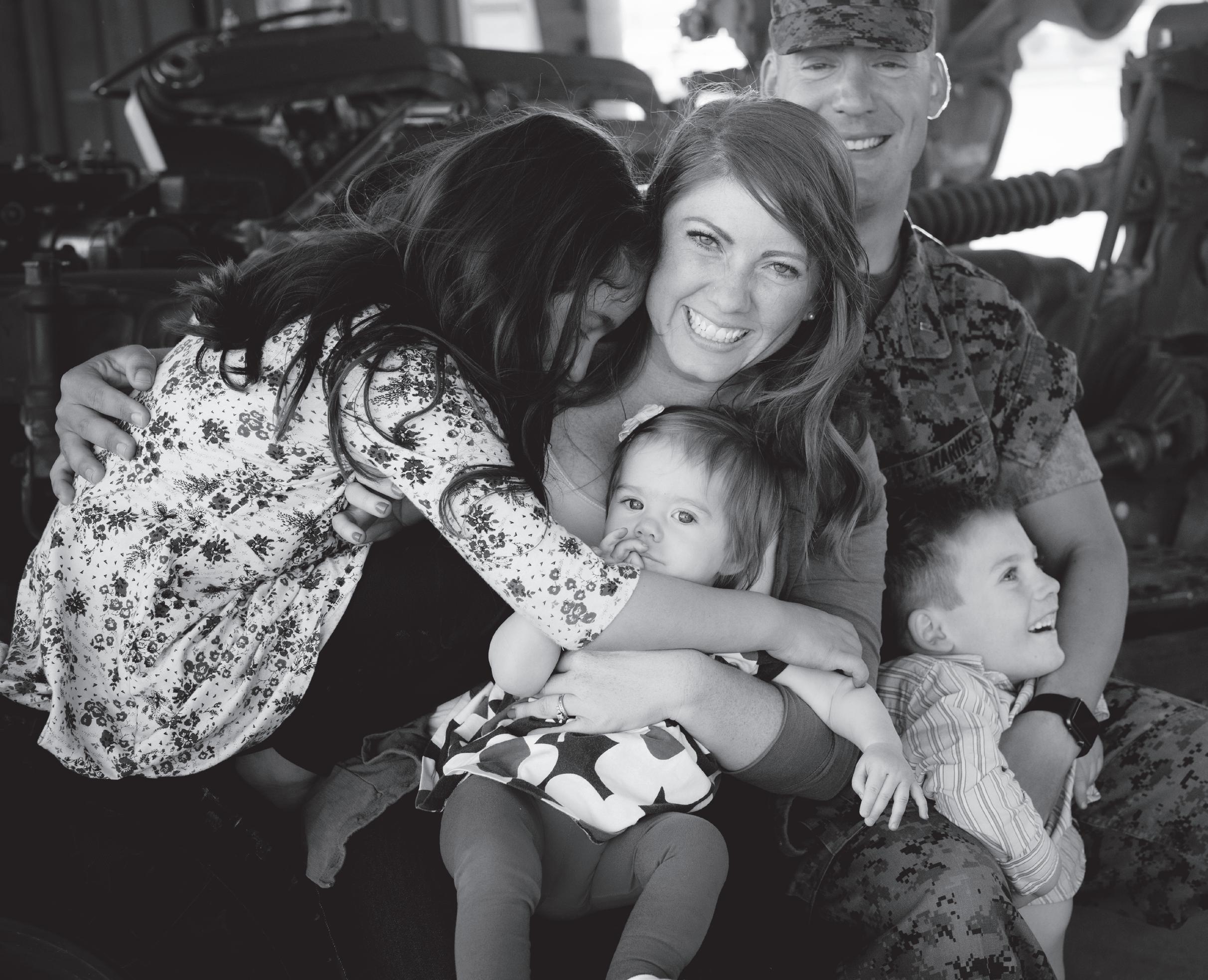
As the world opens back up, use these military discounts to get out there. Keep a little extra money in your wallet, and remember that it never hurts to ask if a military discount is available.
1. Airfare discounts
Many airlines offer discounts to military service people and their families. Unlike government fares, military fares are set aside by airlines for military personnel on leave. To take advantage of the rates, call the airlines directly to inquire about a discount.
2. Space-Available flights
Service members and their families can use Space-Available flights to travel around the country and world at little to no cost. Though often unpredictable, military flights are perfect for families with flexible schedules and great planning skills. Contact your closest Air Mobility Command passenger terminal for specific information. Most terminals have a Facebook page where they post flight information, including their 72-hour flight schedule. More information and eligibility requirements can be found here
3. Baggage fee discounts
Many airlines—Alaska, Allegiant, American, Delta, and JetBlue—will waive or discount baggage fees for military families. After booking a flight, check the airline’s rules for checked luggage.
4. Travel perks through American Express Platinum
American Express now waives its annual fees on its credit cards, including its Platinum credit card. The card provides concierge booking services, five times the points for flights, worldwide airport lounge access, a $200 airline fee allowance, monthly Uber credits, and reimbursement for the TSA Precheck fee. Apply for the credit card and be sure to request its service member benefits.
5. Travel perks through Chase
Chase now waives its credit card fee for the elite card, the Chase Sapphire Reserve, for military members. The card comes with a variety of travel perks, including a $300 travel credit, Global Entry or TSA Precheck fee credit, car rental privileges, and complimentary airport lounge access. Apply for the credit card and be sure to request its service member benefits.
6. AmericanForcesTravel.com
This new travel booking website, the co-brainchild of Priceline and the Department of Defense, provides an easy platform where military families can easily access unique rates on hotels, airfare, rental cars, vacation packages, and cruises.
7. Amtrak rail discounts
Military families are eligible for a 10% discount on the lowest available fares, and military children up to 12 years old are eligible to receive a 10% discount on top of the standard children’s 50% discount.
8. Greyhound fare discounts
Active and retired military service members and their families receive 10% off full-price tickets when purchased at the station.
9. USAA car rental discounts
USAA touts that it can save people up to 25% on car rentals, or even up to 35% if the car is paid for in advance. Plus, fees for additional drivers are waived.
10. Sandals and Beaches Resorts
The all-inclusive resort company offers a year-round 10% discount that is added to any existing promotional rate for all military personnel.
11. DOD lodging
The DOD has hundreds of places to stay around the world, sometimes in basic accommodations and other beachside condominiums, all for military-only guests.
12. Armed Forces Vacation Club
Wyndham Worldwide Corporation offers a free membership program to military families. These condominiumstyle timeshares are located around the world for prices as low as $349 per week. Applications are required.
13. Prestigious military clubs around the world
For a nominal membership fee, military families can gain access to Marines’ Memorial Club & Hotel in San Francisco, only a few blocks from the Golden Gate Bridge. Reciprocal clubs around the world include the Victory Services Club in London and New York Athletic Club in Central Park.
14. Vacation for Vets
The nonprofit In Honor of Our Troops Foundation offers free weeklong vacation accommodations for active-duty service members once a year. Restrictions apply.
15. Free and discounted campsites
Fees at various campgrounds across the nation are eligible to be waived or discounted. For instance, state parks will often waive day use and camping fees on a walk-up, first-available basis and via reservations if a military ID is presented. Tents for Troops is another nationwide program that connects the military with a minimum of two-night complimentary RV and tent sites. Other camping organizations, like KOA, may offer discounts on a location-bylocation basis.
16. Military Epic Pass
The following resorts offer the Military Epic Pass, which costs $189 for activeduty, retired military, and dependents, as well as $579 for veterans and their adult dependents: Beaver Creek Ski Resort in Colorado, Breckenridge Ski Resort in Colorado, Keystone Ski Resort in Colorado, Vail Ski Resort in Colorado, Heavenly Ski Resort in South Lake Tahoe and Okemo Mountain Resort in Vermont.
17. Discounted ski passes for the 2021 winter season
A variety of other discounts are available on the slopes, including Attitash Mountain Resort in New Hampshire, Bear Mountain Resort in Southern California, Camelback Mountain Resort in Pennsylvania, China Peak in California, Crotched Mountain in New Hampshire, Crystal Mountain in Michigan, Diamond Peak, located in northern Lake Tahoe, Dodge Ridge, near Pinecrest, Calif., Eagle Point in Utah, Grand Targhee Resort, located in the Caribou-Targhee National Forest in Wyoming, Homewood Mountain Resort, located on the west shore of Lake Tahoe, Hunter Mountain in New York, Killington Resort in Vermont, Monarch Mountain in Colorado, Mt. Shasta Ski Park in California, Sierra at Tahoe Resort, located in California south of Lake Tahoe, Squaw Valley Alpine Meadows in California, Wildcat Mountain in New Hampshire, and Winterplace Ski Resort in West Virginia. Check specific sites for details.
18. Free admission to select amusement parks
The Waves of Honor program permits any active-duty military, activated or drilling reservist, or National Guardsman and three of their dependents to one free admission per year to Sea World, Busch Gardens, or Sesame Place. Guests must present a military ID to participate and need to apply for the program in advance online through its Troop ID program.
19. Blue Star Museums
Museums across the U.S. commit to giving military families free access.
20. Veterans Advantage membership
The Public Benefit Corporation provides a wide variety of discounts ranging from car rentals, hotels and resorts, dining, movies, and especially for theme parks including Universal Parks, Six Flags, Seaworld, Legoland, and more.
21. Dollywood theme park discount
For country music fans and adrenaline junkies alike, Dollywood offers 30% off a one-day theme park ticket to active duty, retired, disabled veterans, reservists, and dependents.
22. Govx.com
This internet retailer website not only provides discounts on tactical gear, tools, and accessories but also on travel-related items like rental cars, hotels, cruises, and theme parks. It also offers discounted tickets for sports events like baseball, basketball, or hockey games in addition to race registrations and concerts. The membership is free.
23. Free National Parks pass
The annual pass, normally $80, is free for active-duty military members and dependents including Reserve and National Guard members. Obtain the pass in person at any recreation site by showing a valid form of military ID.
24. Legoland amusement parks discounts
Both Legoland resorts offer 10% off admission tickets for active military personnel when purchased at a ticket booth when a valid military ID is presented. Legoland Florida Resort & Water Park, though, gives activeduty service members free admission to its park without any restrictions or blackout dates and can be redeemed at the ticket booth.
25. Knott’s Berry Farm discount
This California amusement park offers discounts on admission tickets to active-duty personnel when a military ID card is presented. They also offer a Military Tribute Days program that gives free admission to active-duty service people, retirees, veterans, and one of their guests on specific days throughout the year.
26. Princess Cruises military benefit program
Princess offers up to $250 in onboard spending money, depending on the length of the stay, for free. The benefit must be applied for in advance no less than 14 days from the departure date.
27. Carnival Cruise Lines
Carnival offers reduced deposits, free room upgrades, and up to $50 onboard credit for trips booked months in advance. One must submit documentation to prove eligibility in advance otherwise benefits could be rescinded.
28. Food discounts
Major restaurant chains like Hard Rock Cafe and Applebee’s often offer a significant discount on the overall bill if a military ID is presented before paying.
29. Retail, gas, and camping discounts
With the Good Sam Club membership, which is more than half off its normal cost of $29 for active-duty military, people can access discounts on fuel at Pilot Flying J gas stations, Camping World SuperCenters, Good Sam parks and campgrounds, and other retail locations.
30. Disney discounts
Walt Disney World offers special military pricing on four- and five-day tickets that include the Park Hopper option so families can come and go from resorts as they see fit.
If you have ever traveled to Japan, then you undoubtedly experienced the amazing culture and hospitality of its people. But who can forget the food?
We first moved to Okinawa in the summer of 2012. It did not take long to realize that if I wanted to find the freshest fruits, veggies, and meat, I would need to head into town. Determined to navigate the aisles like a pro, and armed with my best Charades hand gestures and a few key Japanese phrases, I managed to find everything I needed on that first trip. The prices were reasonable, people were so willing to help, and the food quality was outstanding. I was hooked. So much so, that in 2014, I started a meal kit delivery service on the island, utilizing these amazing ingredients. After five years away, we were lucky enough to return to Okinawa in 2020. Below are a few dishes to bring a bit of Japanese cuisine into your kitchen, wherever that may be!
Ingredients:
For the rice:
1 1/2 cups short-grain rice
2 cups water
3/4 tsp salt
For the cream sauce:
1 ripe avocado, diced
1/4 cup plain yogurt
4-6 tbsp milk
1 tbsp olive oil
1 tbsp lime juice
1 clove garlic, minced
1/4 tsp salt
1/4 tsp pepper
Directions:
Prepare the rice. In a small pot over high heat, bring 2 cups water to a boil. Stir in rice and salt, cover, reduce heat to low, and simmer for 20 mins or until liquid is absorbed. Remove rice from heat and let stand for 10 mins longer.
Active prep time: 30 mins
Total prep/cook time: 35 mins
Taco rice is a dish that originated in Okinawa years ago as a way to attract hungry U.S. troops to local dining establishments. Restaurant owners took the popular seasoned ground beef taco filling and loaded it on a bed of lettuce, served with cheese and tomatoes. This version contains all of the original components, but adds a lime avocado cream sauce to boot!
For the beef:
2 tbsp olive oil
2/3 lb ground beef
3/4 tbsp chili powder
1 1/ 8 tsp cumin
3/4 tsp salt
3/4 tsp pepper
1/2 tsp paprika
3/8 tsp oregano
3/8 tsp garlic powder
3/8 tsp onion powder
For the bowls:
6 cherry tomatoes, halved
Shredded lettuce
1/3 cup shredded Mexican cheese
Meanwhile, add the diced avocado, yogurt, 4 tbsp of the milk, 1 tbsp olive oil, lime juice, minced garlic, 1/4 tsp salt, and 1/4 tsp pepper into a blender or food processor and blend until smooth. Add additional milk as needed to reach a creamy, pourable consistency.
In a skillet over medium heat, add 2 tbsp olive oil, ground beef, chili powder, cumin, paprika, oregano, garlic powder, onion powder, 3/4 tsp salt, and 3/4 tsp pepper. Stir to combine well, cooking for 5-7 mins or until beef is cooked through.
Serve beef on top of the rice along with cherry tomatoes, shredded lettuce, and cheese. Drizzle with avocado cream sauce as desired.

Serves 2-3 people
Active prep time: 20 mins
Total prep/cook time: 6.5 hours
Ingredients:
1 lb pork shoulder
4 cups chicken broth
1/4 cup low sodium soy sauce
1/4 cup rice vinegar
2 tbsp brown sugar
1 tbsp fish sauce
1 tbsp red curry paste
1 tbsp lime juice
1 tbsp sriracha (optional)
2” piece fresh ginger, peeled & grated
1 tbsp minced garlic
1 tbsp sesame oil
1 tsp black pepper
2 blocks dried ramen
2 eggs
2 green onions, thinly sliced
1 jalapeno, thinly sliced
1/2 cup shredded carrots
1/4 cup peanuts, chopped
Directions:
Ramen is a staple meal in Japan. While there are too many versions to count, this Crock-Pot style option takes some flavor influences from Thai cuisine to put a unique spin on a traditional dish.

Remove the pork from the packaging and pat dry with paper towels. Cut the pork into 2-3 smaller pieces, then add to a Crock-Pot. To the Crock-Pot, add in the chicken broth, soy sauce, rice vinegar, brown sugar, fish sauce, red curry paste, lime juice, sriracha, ginger, garlic, sesame oil, and pepper. Stir until the sauce is well combined, then cover and cook on low heat for about 6 hours, or until the pork is tender. Shred pork using two forks, then place it back into the liquid.
Next, add two eggs to a small pot of water of med-high heat. Once the water starts to boil, set a timer for 5
mins. After the timer goes off, remove the eggs from the heat then place them into a bowl filled with ice water (this stops the cooking process).
Place the ramen noodles into the Crock-Pot and turn off the heat. Gently stir, then allow the noodles to soften in the broth for about 3-4 mins. Immediately spoon into the bowls and top with sliced green onions, carrots, jalapeno, and chopped peanuts.
Remove shells from the eggs, then cut each egg in half and add to the ramen bowls before serving.
Continued from page 24
Army, married 8 years
Their love story: Jimmy and Kristen had only dated a few months when Kristen said, “I found a way to pay for medical school, but I might wind up anywhere in the world. What do you think?” Without missing a beat, Jimmy replied, “I would go with you.” And he did.
“He always dives right in, no questions asked,” Kristen said. As a couple, they have consistently worked to divide and conquer. When Jimmy realized re-earning his EMS certification after every move would be a challenge, he shifted professional gears to stay-at-home dad. He has become a “diaper connoisseur” and “dealer of naps and snacks.” Two moves and two kids later, they are most proud of the
Retired Navy, married 42 years

Their love story:
Jim and Rhonda Lawrence have been fighters from the beginning. During Jim’s first tour, an administrative error documented him as unmarried, and he was sent overseas unaccompanied without his wife and baby. Rhonda marched down to the base and told them that would not do and that they should send her to Japan. And they did. Learning to survive and thrive together in a foreign country was a blessing in disguise for their marriage, “If we got in an argument ... well, you can’t run home to mama when you’re overseas,” Rhonda said. “You work it out.”
During 20 years of service, they navigated times together and apart — before email or FaceTime — as Jim climbed the ladder
family they’ve built, basking in “those fairytale moments.”
Their advice:
1. Make time to share moments. On Kristen’s daily drive home, Jimmy calls and updates her on the kids’ day. “Sharing that experience makes you feel less isolated,” Kristen said. “I sometimes feel isolated working, and Jimmy feels isolated at home with a 4and 6-year-old. Communication helps us feel involved.”
2. Acknowledge your spouse’s experience.
To the active-duty partner, Kristen says that you should appreciate your spouse’s point of view. “The military is a decision you made for your career, and they’re along for the ride because they love you. This wasn’t a choice they would have made for themselves ... appreciate the ways they sacrifice for your goals.”
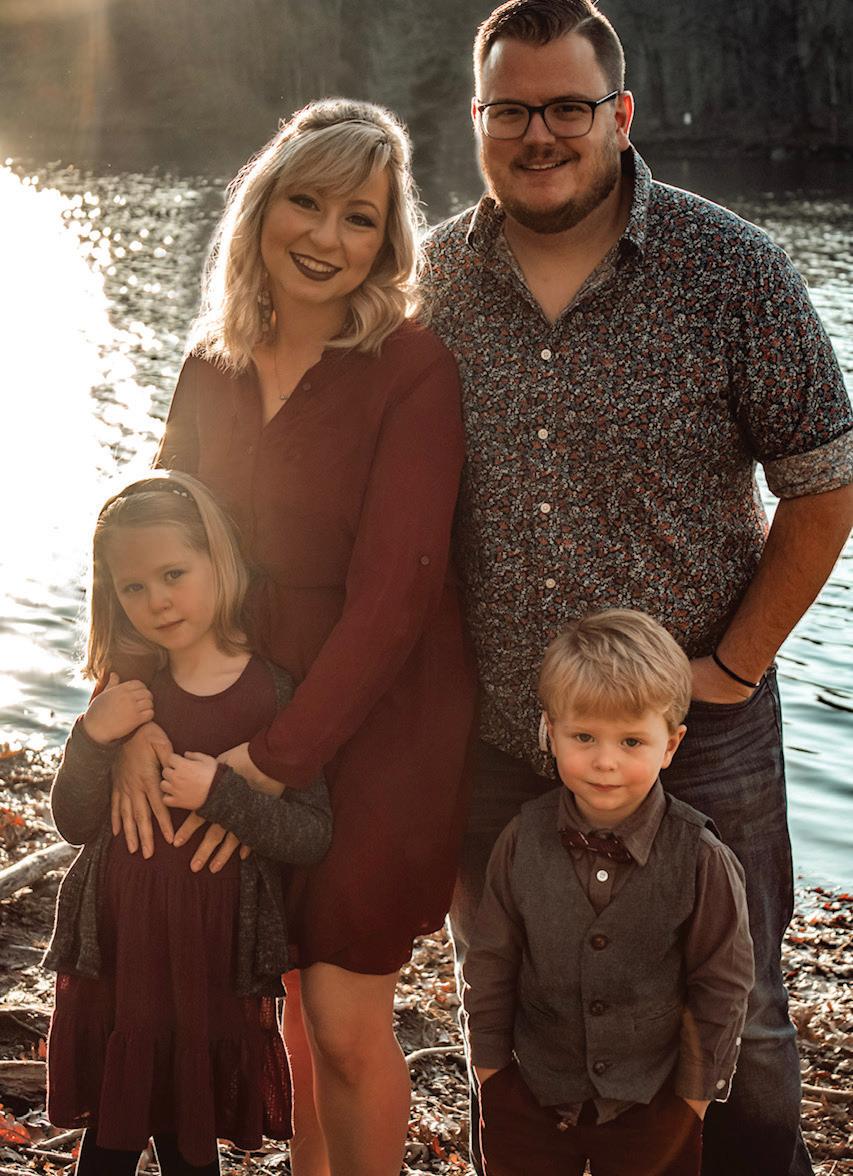
to master chief. The lessons they learned lasted through the decades.
Their advice:
1. Never forget where you started. “I always remember being an E-1’s wife. It’s easy to get caught up in titles and ranks but remembering what you’ve been through together helps you appreciate what you have,” Rhonda said.
2. Remember what’s important. Jim encourages service members to prioritize family as much as possible. “Family is what will be there for you on the back side of your service.”
3. Prove people wrong. Going all-in has fostered Jim and Rhonda’s marriage over more than four decades. According to Rhonda, family, friends, or coworkers may think you’re ruining your life by
3. Know when to tap out, and when to talk.
“We communicate when one of us needs to tap out from parenting for 10 minutes ... and we use pillow talk to reconnect and just be humans together,” Jimmy said.
joining or marrying into the military. To that, Rhonda says, “Watch me.” She still remembers being a young wife and saying to Jim, “We’re gonna prove everybody wrong.” And they did — in love, in work, and in family.
